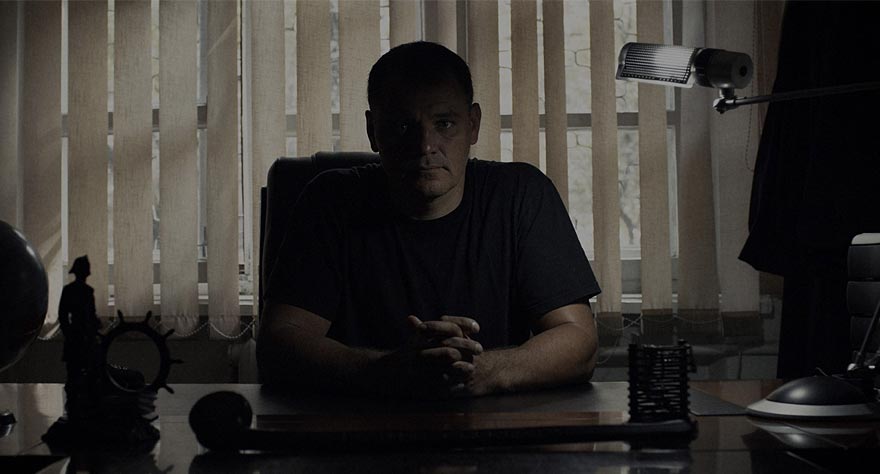
Steve Hoover explores murky moral waters in this fascinating portrait of a self-styled hero.

Steve Hoover explores murky moral waters in this fascinating portrait of a self-styled hero.
“I don’t need permission to do good things.” states Pastor Gennadiy Mokhnenko halfway through Steve Hoover’s absorbing, unsettling sophomore feature Almost Holy (originally titled Crocodile Gennadiy). Mokhnenko wears the collar of a clergyman, but he also devotes himself to vigilante activities, scooping drug-addicted kids off the streets of his hometown, Mariupol, Ukraine, and forcing them into rehabilitation. He’s a charismatic, outsized presence, and his self-assurance in making that statement provides the documentary with its tricky moral quandary.
Hoover’s crew follows Mokhnenko on his nocturnal raids of gruesome shooting galleries around the city. The Pastor’s nickname “Pastor Crocodile” comes from an old Soviet-era children’s show, where a friendly crocodile goes about righting wrongs and battling an evil witch. Some of the kids Mokhnenko encounters with track marks on their arms are as young as ten-years-old. These kids have fallen through the cracks of society and belong to broken families with parents who themselves are junkies or alcoholics. Simply put, there’s no-one around to help them. There’s no state scheme to aid their plight, and the police are shockingly apathetic. The situation creates a space for someone like the Pastor, operating in grey areas of the law. Once in his care, he adopts some of them, and under his patronage, many will go on to lead healthy, normal lives. Others will leave or escape back to the “freedom” of the streets.
Hoover weaves together footage to create a portrait of this self-styled saviour. Hoover eschews a straight narrative by using a fragmented series of vignettes, skipping back and forth through time. With the aid of cinematographer John Pope and utilizing a discordant score of industrial ambience, Hoover creates an atmosphere of hallucinatory dissociation, presenting the Ukraine as a post-Communist dystopia. News footage and soundbites chronicling the country’s troubled recent history put the events in some context, Mokhnenko’s rescued souls representing smaller, more personal dramas set against a backdrop of national identity crisis.
Mokhnenko is a person of boundless energy and self-confidence. He has set up 40 rehabilitation centres under the banner “Pilgrim Republic”. Mokhnenko describes feeling like Superman when he first saved someone’s life, working as a firefighter in his younger years. It’s interesting that he reaches for the Man of Steel comparison, when his methods are closer to those of Batman. Dressed all in black, with a long coat flapping round him like a cape and an oversized crucifix on his chest like an emblem, he’s a self-modelled dark knight, as comfortable roughing up sex offenders as he is making insinuating threats to pharmacies supplying under-the-counter drugs to kids.
Hoover presents many of the episodes in stark verite style, showing the harrowing reality of the drug addict’s surroundings. One especially squalid encounter involves a mentally ill, deaf and dumb woman kept in a shed by an older man, who routinely sexually abuses her. Distraught and discombobulated, the woman can’t even remember or articulate what became of her baby, a mystery that Pastor Crocodile later resolves. As self-cast judge and jury in the cases Mokhnenko involves himself in, he decides that she should be taken into psychiatric care, and cooks up a bogus statement to make sure the hospital accepts her admission.
While Hoover describes the film as a portrait, the most significant problem with Almost Holy is a lack of perspective. It becomes obvious that the director is enamoured by Mokhnenko’s outsized personality when he treats him like a movie star, filming him swim in slow motion and working out at the gym. At times it feels a little like hero-worship, showing the Pastor as an inspirational speaker, a badass on the streets, a political firebrand, and a father to his extended family of lost boys.
On the flip side, Hoover often lights the pastor from behind or obscures his face with shadow, making him look like a gangster. Hoover acknowledges the shady side of the pastor’s activities, without offering any opinion of his own. These conflicted directorial choices make it a little difficult to decide what the Hoover’s actual stance is, and testimonies from other people in the story would give us a more rounded portrait of the man. Is the pastor motivated by fame, power and self-interest, as his critics suggest, or moved to help these people by a genuine sense of altruism? Is he playing tough for the cameras, or his he toning down his methods because a camera is present? What do his rescuee’s really feel about the pastor’s methods, once their past the shock of being virtually abducted by him?
“I don’t need permission to do good things.” Pastor Crocodile states, and in his environment that statement is at least partially true. It seems that he has transcended the law and is doing whatever he feels is best. The difficulty is that in doing his good deeds, he takes the voiceless from one dire situation and puts them in another where once again their feelings or opinions are disregarded. The question hanging over the whole piece is this—Gennadiy Mokhnenko is saving these people from themselves with his questionable methods, but should he? In many cases shown here, he’s rescuing them against their will.
Almost Holy is a handsomely shot documentary (though not surprisingly considering Terrence Malick as an executive producer) and some segments are as well-crafted as a prestige fiction film. With a charismatic and enigmatic central figure like the Pastor Crocodile, it should go down well with discerning arthouse audiences, and offers plenty to debate.